This article needs additional citations for verification .(March 2024) |

The Owls' Nest is a drawing by Hieronymus Bosch, [1] now in the Museum Boijmans Van Beuningen. [2]
This article needs additional citations for verification .(March 2024) |

The Owls' Nest is a drawing by Hieronymus Bosch, [1] now in the Museum Boijmans Van Beuningen. [2]

Hieronymus Bosch was a Dutch painter from Brabant. He is one of the most notable representatives of the Early Netherlandish painting school. His work, generally oil on oak wood, mainly contains fantastic illustrations of religious concepts and narratives. Within his lifetime, his work was collected in the Netherlands, Austria, and Spain, and widely copied, especially his macabre and nightmarish depictions of hell.
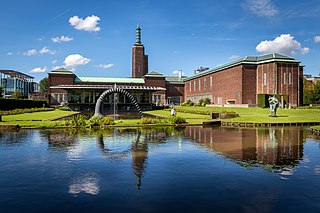
Municipal Museum Boijmans Van Beuningen is an art museum in Rotterdam in the Netherlands. The name of the museum is derived from the two most important collectors of Frans Jacob Otto Boijmans and Daniël George van Beuningen. It is located at the Museumpark in the district Rotterdam Centrum, close to the Kunsthal and the Natural History Museum.

The Wayfarer is an oil-on-panel painting by the Early Netherlandish artist Hieronymus Bosch, created c. 1500. It is now in Museum Boijmans Van Beuningen in Rotterdam. This painting is round and 71.5 cm (28.1 in) in diameter. It is one of the fragments of a partially lost triptych or diptych, which also included the Allegory of Gluttony and Lust, the Ship of Fools and Death and the Miser.

Hans Bol or Jan Bol, was a Flemish painter, miniature painter, print artist and draftsman. He is known for his landscapes, allegorical and biblical scenes, and genre paintings executed in a late Northern Mannerist style.

The Marriage Feast At Cana is a painting that was formerly attributed to the Early Netherlandish master Hieronymus Bosch. The painting is in the Museum Boijmans Van Beuningen in Rotterdam, the Netherlands. Several copies exist of this picture. The copy in Boijmans had been considered the original. Dendrochronological analysis has proven conclusively that it cannot have been painted earlier than 1550.
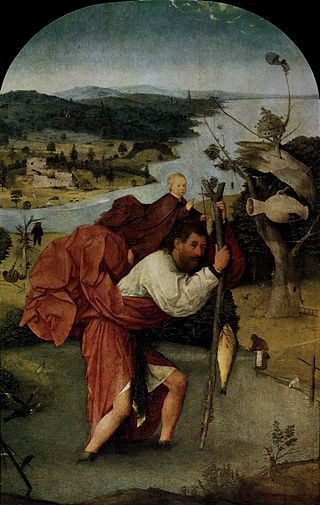
Saint Christopher Carrying the Christ Child is an oil on panel painting by Dutch painter Hieronymus Bosch, dating to c. 1490–1500. It is in the Museum Boijmans Van Beuningen in Rotterdam.
Head of a Woman is a fragment of a Hieronymus Bosch painting, created c. 1500. It is currently in the Museum Boijmans Van Beuningen in Rotterdam, Netherlands. The fragment is only 13 cm tall and 5 cm wide.
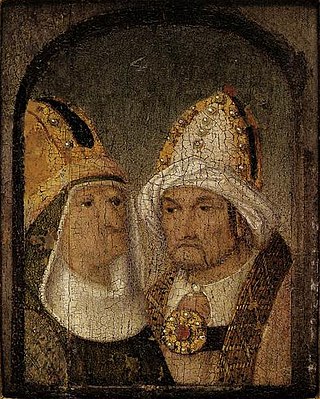
Two Male Heads is an anonymous painting formerly attributed to the Early Netherlandish painter Hieronymus Bosch. It is currently in the Museum Boijmans Van Beuningen in Rotterdam.

Rob Scholte is a Dutch contemporary artist. From 1977 to 1982 he studied at the Gerrit Rietveld Academie, Amsterdam. His work consists of reproductions of images from the media and from art history. He lives and works in Den Helder.

Hieronymus Cock, or Hieronymus Wellens de Cock was a Flemish painter and etcher as well as a publisher and distributor of prints. Cock is regarded as one of the most important print publishers of his time in northern Europe. His publishing house played a key role in the transformation of printmaking from an activity of individual artists and craftsmen into an industry based on division of labour. His house published more than 1,100 prints between 1548 and his death in 1570, a vast number by earlier standards.
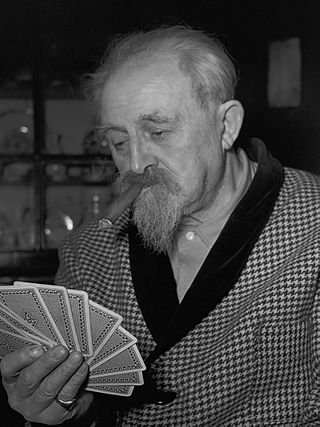
Johannes Carolus Bernardus (Jan) Sluijters, or Sluyters was a Dutch painter and co-founder of the Moderne Kunstkring.

Franz Wilhelm Koenigs was a German banker and art collector.

Concert in the Egg is a painting formerly considered to be a copy of a lost work by Hieronymus Bosch, and which is currently considered to be based on one of his drawings. Max Jakob Friedländer called it 'an old copy', without specifying another work it was copied from.
Rinus van den Bosch was a Dutch artist, who worked as sculptor, photographer, installation artist, painter, and draftsman.

The Fall of the Rebel Angels is an oil-on-panel painting of 1562 by the Netherlandish Renaissance artist, Pieter Bruegel the Elder. The painting is 117cm x 162cm and is now in the Royal Museums of Fine Arts of Belgium in Brussels, Belgium. The Fall of Rebel Angels depicts Lucifer along with the other fallen angels that have been banished from heaven. Angels are falling from the sun in a stacked manner along with ungodly creatures that Bruegel created. This piece by Bruegel was previously thought to be by Hieronymus Bosch. Bruegel was influenced by a variety of artists such as Albrecht Dürer, Frans Floris I, and Hieronymus Bosch. He also got ideas for the creation of his creatures in his previous works.
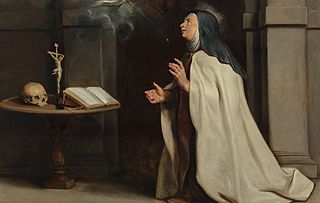
Saint Teresa of Ávila's Vision of the Holy Spirit is a 1612-1614 painting by Peter Paul Rubens. It is now in the Museum Boijmans Van Beuningen in Rotterdam.

The Goldweigher's Field is a 1651 etching by Rembrandt now held by many museums, including the British Museum, the Rijksmuseum, The Morgan Library & Museum, and the Metropolitan Museum of Art. It is based on a landscape drawing in the collection of the Museum Boijmans van Beuningen.

Pieter van der Heyden was a Flemish printmaker who is known for his reproductive engravings after works by leading Flemish painters and designers of the 16th century.

The Flood Panels are two double-sided painted panels attributed to the Early Netherlandish artist Hieronymus Bosch, dating to c. 1514 and now in the Museum Boijmans Van Beuningen in Rotterdam.
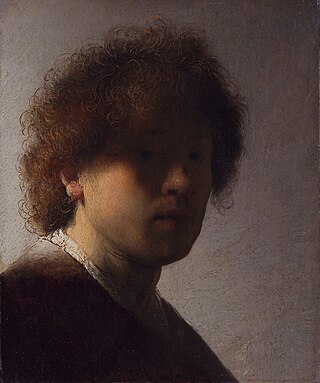
Vereniging Rembrandt is a Dutch association of art patrons who raise funds to assist Dutch museums and art galleries in purchasing artworks. Since it was founded in 1883, it has helped purchase over two thousand works, including Vermeer's The Milkmaid.